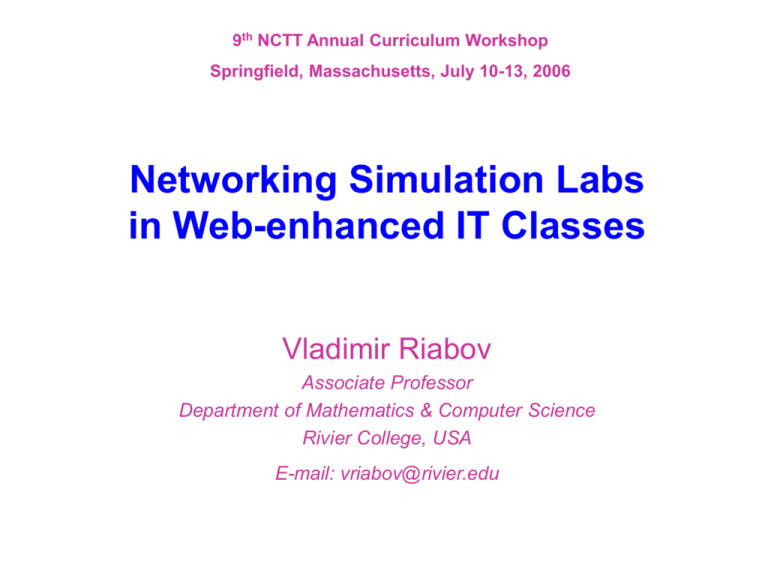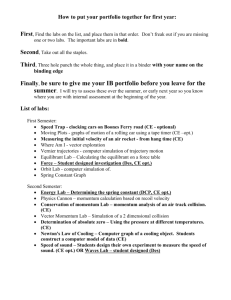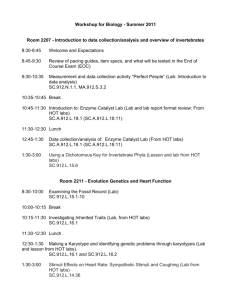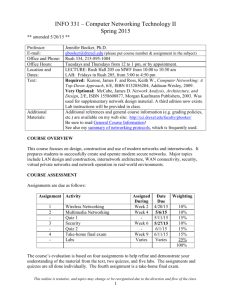Networking Systems Code Studies
advertisement

9th NCTT Annual Curriculum Workshop Springfield, Massachusetts, July 10-13, 2006 Networking Simulation Labs in Web-enhanced IT Classes Vladimir Riabov Associate Professor Department of Mathematics & Computer Science Rivier College, USA E-mail: vriabov@rivier.edu Agenda: • • • • Web-enhanced IT Classes at Rivier College; Lecture Notes and Web Resources; Virtual OPNET Labs; Simulation Techniques in Students’ Research Papers: – – – – • • Project Papers (SANs, WiFi, Gigabit Ethernet, etc.) Digital Video Cluster Simulation with OMNeT++ Ethernet and Switched LANs Simulation with OPNET Simulating Retransmissions for a WiFi-PCF-enabled Stations Workshop Lab: Small Intranet Simulation with OPNET Conclusion July 2006 Networking Simulation Labs 2 Web-enhanced IT Classes at Rivier College • Undergraduate and Graduate Programs in CS & IT http://www.rivier.edu/departments/mathcs/home/cs/CSIndex.htm • Certificates in Networking and Information Technologies • IT-related Courses: – – – – – – – – CS553: Introduction to Networking Technology CS572: Computer Security CS573: Advanced Wide Area Networks CS575: Advanced Local Area Networks CS597: Multimedia and Web Development CS612: Information Technology CS632: Client/Server Computing CS685: Network Management, and others • Web-enhanced Classes and Virtual Labs across CS/IT Curricula July 2006 Networking Simulation Labs 3 Lecture Notes and Web Resources • Instructor’s Web site (Teaching, Research & Publications): http://www.rivier.edu/faculty/vriabov/ • Web sites for IT Courses – – – – – – – Syllabi Lecture Notes Virtual OPNET™ Labs Assignments Schedules Resources Examples of Students’ Project Papers • Web Resources July 2006 Networking Simulation Labs 4 Class Assignments • • • • • • • Warm-up Exercises Homework Assignments Virtual Labs Midterm Exams Project Papers Research Reports Final Exams July 2006 Networking Simulation Labs 5 Warm-up Exercises (examples) • What is the last digit of the number 25975927 [mod(10)]? • Using MSExcel™ spreadsheet, find the last digit of the number 719 [mod(10)]? • How to use your findings in these two cases for encrypting e-messages? July 2006 Networking Simulation Labs 6 What is the last digit of the number 25975927 [mod(10)]? • • • • • • • • • It’s enough to consider the last digit of a simpler number 75927; Do your experiments (see Table)! “LAST” can be 7, 9, 3, or 1 only; therefore, it is a cycle of four cases; The power, 5927 can be represented as 5927 = 4*1481+3; Therefore, “LAST” of 75927 is the same as the “LAST” of 73, which is “3”. Answer: “3”. Try MS Excel™Spreadsheets (see Table)! Why the last digit of the number 7N at N > 18 is 0 there? HINT: Consider the number of “valuable” digits in large natural numbers calculated with MS Excel™! July 2006 Networking Simulation Labs 7^N N 1 2 3 4 5 6 7 8 9 10 11 12 13 14 15 16 17 18 19 20 7 49 343 2401 16807 117649 823543 5764801 40353607 282475249 1977326743 13841287201 96889010407 678223072849 4747561509943 33232930569601 232630513987207 1628413597910450 11398895185373100 79792266297612000 7 Homework Assignments (example 1) • Using Manchester Encoding Format, encode a bit-stream that represents two first letters of your last name previously written in the ASCII (7-bit) Coding Standard. Using MS Word, plot a diagram that illustrates your Manchester code. July 2006 Networking Simulation Labs 8 Homework Assignments (example 2) • Plot a diagram that illustrates a virtual private connection from your home computer to the Rivier College Network. Briefly describe issues that should be resolved for establishing this connection. July 2006 Networking Simulation Labs 9 Homework Assignments (example 3) A LAN has a data rate of r=4 Mbps and a propagation delay between two stations at opposite ends of d=20 μs. For what range of PDU sizes (S, measured in bits) does the stop-and-wait flow control give an efficiency of at least 50%, E > 0.5? (neglect the transmission time for the ACK signal). The efficiency, E is defined as a ratio of the PDU transmission time (time for inserting the PDU onto the medium) to the total time the medium is occupied for this one PDU. Stop-and-wait flow control Crystal Yu’s solution: S=? T=S/r is PDU-transmission time; E=T/(T+d+d); E > 0.5; T>0.5*(T+2*d); T>2d; S>2*d*r; S>2*20*10-6*4*106; Answer: S>160 bits July 2006 Networking Simulation Labs 10 Visiting the IT Services Department July 2006 Networking Simulation Labs 11 Visiting the IT Services Department July 2006 Networking Simulation Labs 12 OPNET Virtual Labs • OPNET IT Guru Academic Edition™ : – http://www.opnet.com/services/university/home.html • OPNET Virtual Lab Manuals: – http://www.opnet.com/services/university/lab_manuals.html • William Stallings, Business Data Communications, Fifth Edition; • William Stallings, Data and Computer Communications, Seventh Edition; • Raymond R. Panko, Business Data Networks and Telecommunications, Fourth Edition; • Larry L. Peterson and Bruce S. Davie, Computer Networks – A Systems Approach,Third Edition; • OPNET IT Guru Academic Edition – A Tool for Networking Education, Regis University; • Security Labs in IT Guru Academic Edition, Universitat Ramon Llull, Spain. July 2006 Networking Simulation Labs 13 Virtual Labs Four-Six OPNET™ Virtual Labs per Course: (Larry L. Peterson and Bruce S. Davie, Computer Networks – A Systems Approach, Third Edition) • • • • • • • • • • • • • L00: Introduction - Basics of OPNET IT Guru Academic Edition™ L01: Ethernet - A Direct Link Network with Media Access Control L02: Token Ring - A Shared-Media Network with Media Access Control L03: Switched LANs - A Set of Local Area Networks Interconnected by Switches L04: Network Design - Planning a Network with Different Users, Hosts, and Services L05: ATM - A Connection-Oriented, Cell-Switching Technology L06: RIP: Routing Information Protocol - A Routing Protocol Based on the Distance-Vector Algorithm L07: OSPF: Open Shortest Path First - A Routing Protocol Based on the Link-State Algorithm L08: TCP: Transmission Control Protocol - A Reliable, Connection-Oriented, ByteStream Service L09: Queuing Disciplines - Order of Packet Transmission and Dropping L10: RSVP: Resource Reservation Protocol - Providing QoS by Reserving Resources in the Network L11: Firewalls and VPN - Network Security and Virtual Private Networks L12: Applications - Network Application Performance Analysis July 2006 Networking Simulation Labs 14 Virtual Lab Basics July 2006 Networking Simulation Labs 15 Lab Project Editor Window July 2006 Networking Simulation Labs 16 Lab: Network Expansion Plan (We will build these networks during the NCTT Workshop today) In this lesson, you plan for the expansion of a small company’s intranet. Currently, the company has a star topology network on the first floor of its office building and plans to add an additional star topology network on another floor. You will build and test this “whatif” scenario to ensure that the load added by the second network will not cause the network to fail. July 2006 Networking Simulation Labs 17 Creating a New Scenario Use the Startup Wizard to set up a new scenario: 1 If IT Guru is not already running, start it. 5 Enter the values shown in the following table in the dialog boxes of the Startup Wizard: 2 Select File > New.... 3 Select Project from the pull-down menu and click OK. 4 Name the project and scenario, as follows: 4.1 Name the project <initials>_Sm_Int Include your initials in the project name to distinguish it from other versions of this project. 4.2 Name the scenario first_floor. 4.3 Click OK. The Startup Wizard opens. July 2006 Networking Simulation Labs 18 Creating the Network July 2006 Networking Simulation Labs 19 Creating the Network (Step 2) Building a Server, Application & Profile July 2006 Networking Simulation Labs 20 Expanding the Network & Comparing Results (Step 3) Comparing Results July 2006 Networking Simulation Labs 21 Students’ Project Papers: “Storage Area Networks (SANs)” Fibre Channel Technology for Storage Area Networks by David Norman (fibre.pdf file is available) July 2006 V. Riabov, "Storage Area Networks," The Internet Encyclopedia, Wiley & Sons, Dec. 2003, pp. 1-11. Networking Simulation Labs 22 Students’ Project Papers on Selected Networking Protocols Gigabit Ethrnet, QoS, and Multimedia Applications by Jeff Corbit (gigabit-ethernet.pdf file is available) July 2006 V. Riabov, “Simple Mail Transfer Protocol," The Handbook of Information Security, Wiley & Sons, Dec. 2005, pp. 1-22. Networking Simulation Labs 23 Students’ Project Papers: “WiFi Technologies” Secure Wi-Fi Technologies for Enterprise LAN Network by Tom Borick (wifi.pdf file is available) July 2006 V. Riabov, “Going Wireless," Rivier Today Magazine, March 2005. Networking Simulation Labs 24 Digital Video Cluster Simulation with OMNeT++ Digital Video Cluster Simulation by Martin Milkovits (cluster.pdf file is available) Varga, Andras. 2004, OMNeT++ Version 3.0 User Manual [online]. Available via <http://www.omnetpp.org/>. July 2006 Networking Simulation Labs 25 Digital Video Cluster Simulation (continue) From: Digital Video Cluster Simulation by Martin Milkovits July 2006 Networking Simulation Labs 26 Digital Video Cluster Simulation (results) From: Digital Video Cluster Simulation by Martin Milkovits July 2006 Networking Simulation Labs 27 Lab Report: Ethernet Study with OPNET™ (available from: http://www.rivier.edu/journal/ROAJ-2005-Fall/J16-KUMAR.pdf) July 2006 Networking Simulation Labs 28 Project: Wi-Fi Technology Simulation with OPNET™ (CS575 Project Paper by Vandana Wekhande, Spring 2006) July 2006 Networking Simulation Labs 29 Conclusions • Web-enhanced classes and virtual labs in Networking Technologies and other related areas provide students with better instructional support than “traditional” classes; • Warm-up in-class exercises, homework assignments, lecture notes, field trips to IT Service Department, and virtual labs help students being familiar with modern state-of-the-arts networking technologies; • Students’ challenge projects and research become vital components of their active studies at colleges that help students finding jobs and being promoted in the networking companies; • Instructional openness and support become powerful resource for students in classroom and in their future professional life. July 2006 Networking Simulation Labs 30






